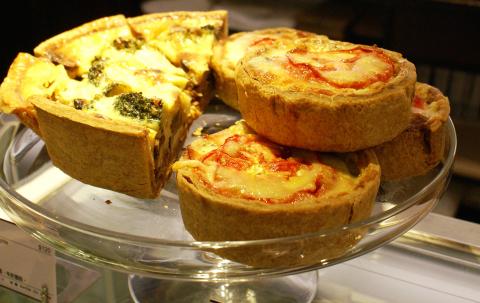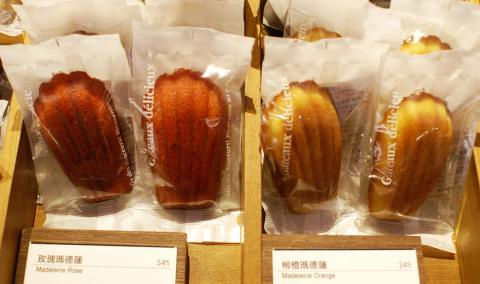Chiu Dai-yu’s (邱岱玉) first foray into Taipei’s baked goods market in 1995 fell as flat as a German flammkuchen. Consumers weren’t ready for the taste and texture of high-end European bread.
“Customers would return the bread and say there is something wrong with it — the sourdough rye, for example, is too sour,” said Chiu, who lived and worked in Germany for several years.
The bakery closed. Unwilling to abandon her dream and gambling that tastes were changing, Chiu opened Oma Ursel’s German Bakery in 1999. Twelve years later and with three branches and a German restaurant to her name, Chiu says she “no longer worries that people will return our bread because they think it’s strange.”

Photo: Noah Buchan, Taipei Times
Chiu says her bakeries grew steadily before they “took off like a plane” three years ago.
In addition to Wendel’s German Bakery and Bistro, which opened its fifth branch a few weeks back, Taipei has seen French bakery chain Paul open two locations in the capital city since 2008.
Lalos, a French bakery part-owned by renowned chef Frederic Lalos, opened its first branch outside of Paris at Taipei 101 in October, and Oma Ursel’s German Bakery and six-year-old Boite de Bijou (珠寶盒法式點心坊) plan to open more branches in the capital next year.

Photo: Noah Buchan, Taipei Times
And then there are the dozens of European-style bakeries and patisseries that have opened in hotels and shopping malls across the capital.
“The Taiwanese are traveling a lot and are very open-minded when it comes to trying different food — just look at all the different restaurants in Taipei right now that have flavors from all over the world,” said Patti Ho (何孟澔), chief operating officer of the company that runs Lalos.
“Bakeries are part of this trend,” she said.

Photo: Noah Buchan, Taipei Times
While these bakeries are changing eating habits, growing consumer demand is changing the way bakeries run their business.
All in good taste
Mention of Taiwanese bakeries used to bring to mind sickly sweet white bread, or buns stuffed with limp vegetables, all manner of processed meat, lashings of mayonnaise (or salad sauce, 沙拉醬) and greasy cheese.

Photo: Noah Buchan, Taipei Times
No longer. European bread, with its higher whole wheat and whole grain content, is firmer than the starchier, softer and ultimately less healthy varieties. More whole wheat content means more fiber, protein, minerals and vitamins.
Whereas Chiu used to spend time convincing her customers of her bread’s healthful properties, today she finds customers trying to educate her.
“Consumers have become far more savvy,” she said.
Citing fiber as an example, Chiu said it is common for her customers to ask detailed questions about how much of it individual breads contain.
“Those concerned about diabetes, high blood pressure and heart disease are especially fiber-conscious,” she said.
A study published last month by the Division of Sports and Cardiovascular Nutrition at Michigan State University in the US found that teenagers raised on high-fiber diets are less likely to have risk factors associated with those diseases. And as waist sizes expand, a high-fiber diet is becoming more important in combating obesity, the study reported.
But whole wheat bread in Taiwan might not be as healthful as customers think as labeling standards set by the Department of Health are not as strict as those in Europe.
“The standard in Germany is 100 percent. You cannot say that it’s whole wheat bread unless it’s 100 percent whole wheat. In Taiwan, it only has to contain 28 percent,” Chiu said.
Consequently, some bakeries add molasses to dough to give their bread a whole wheat appearance. “Customers used to think whole wheat bread was black. Today, people know better,” Chiu said.
Setting the standard
In addition to high-quality bread, staffing stores with professional and knowledgeable employees versed in the finer details of the products they sell has been key to the growth of European-style bakeries.
Susan Lin (林淑真), managing director of Boite de Bijou, says new employees undergo training at the company’s office above its Anhe Road branch in Taipei before they start serving customers.
Classes cover topics ranging from the various ingredients in the company’s desserts, to how to cut bread. More importantly, Lin says, she teaches her employees what to pair bread with.
“I always tell my customers that eating German bread is like eating a bowl of rice: it’s best accompanied with something else — cheese, salami or a spread like peanut butter,” Chiu said.
Boite de Bijou stocks a line of homemade jelly, jam, honey and peanut butter for this purpose. Oma’s, like the recently opened Lalos, provides samples of most of its breads.
Though Boite de Bijou’s bakers are all trained in Taiwan, Lin said they visit Japan and France every year “to learn the latest bread and dessert trends in those countries.”
Chiu said increased competition prompted her to team up with Peter Neyenhuys, a master baker with 30 years of experience under his belt.
Neyenhuys spent three years at school studying how to bake bread and two years on pastry before he was accepted as an apprentice under a master baker. After three years of starting work at 4am and learning everything from how to store products and the chemical interactions of ingredients to the ins and outs of running a business, he earned a diploma as a master baker. The whole process took 10 years.
Unwilling to speculate on the influence bakeries such as Paul have had on the market, Lin says that 85°C (85度C) bakery and coffee chain, which opened in 2004, did much to draw attention to Western-style desserts.
“The number of locations it has throughout Taiwan and its high-profile advertising and promotion of desserts ... has had a tremendously positive effect on my business,” she said.
Wu Pao-chun (吳寶春), who took top honors in the master baker category at France’s 2010 Bakery World Cup, has also drawn attention to high-end breads and desserts.
And it’s not just local consumers who are taking notice of Taipei’s bakeries. A blogger named Doreen Sia from Singapore who visited Boite de Bijou’s Anhe Road store in March, for example, raved about its desserts.
“In Singapore you wouldn’t get to enjoy pastries that are as good for this price. Plus, I haven’t even found any patisserie in Singapore that can beat Boite de Bijou,” she wrote.

June 2 to June 8 Taiwan’s woodcutters believe that if they see even one speck of red in their cooked rice, no matter how small, an accident is going to happen. Peng Chin-tian (彭錦田) swears that this has proven to be true at every stop during his decades-long career in the logging industry. Along with mining, timber harvesting was once considered the most dangerous profession in Taiwan. Not only were mishaps common during all stages of processing, it was difficult to transport the injured to get medical treatment. Many died during the arduous journey. Peng recounts some of his accidents in

“Why does Taiwan identity decline?”a group of researchers lead by University of Nevada political scientist Austin Wang (王宏恩) asked in a recent paper. After all, it is not difficult to explain the rise in Taiwanese identity after the early 1990s. But no model predicted its decline during the 2016-2018 period, they say. After testing various alternative explanations, Wang et al argue that the fall-off in Taiwanese identity during that period is related to voter hedging based on the performance of the Democratic Progressive Party (DPP). Since the DPP is perceived as the guardian of Taiwan identity, when it performs well,

The Taiwan People’s Party (TPP) on May 18 held a rally in Taichung to mark the anniversary of President William Lai’s (賴清德) inauguration on May 20. The title of the rally could be loosely translated to “May 18 recall fraudulent goods” (518退貨ㄌㄨㄚˋ!). Unlike in English, where the terms are the same, “recall” (退貨) in this context refers to product recalls due to damaged, defective or fraudulent merchandise, not the political recalls (罷免) currently dominating the headlines. I attended the rally to determine if the impression was correct that the TPP under party Chairman Huang Kuo-Chang (黃國昌) had little of a

At Computex 2025, Nvidia CEO Jensen Huang (黃仁勳) urged the government to subsidize AI. “All schools in Taiwan must integrate AI into their curricula,” he declared. A few months earlier, he said, “If I were a student today, I’d immediately start using tools like ChatGPT, Gemini Pro and Grok to learn, write and accelerate my thinking.” Huang sees the AI-bullet train leaving the station. And as one of its drivers, he’s worried about youth not getting on board — bad for their careers, and bad for his workforce. As a semiconductor supply-chain powerhouse and AI hub wannabe, Taiwan is seeing